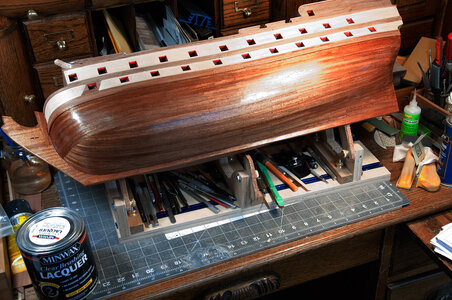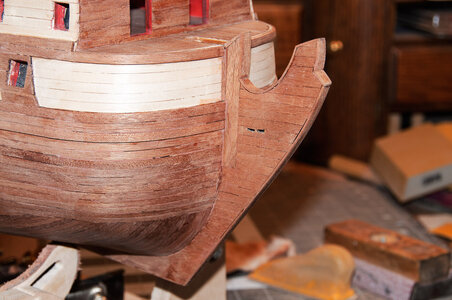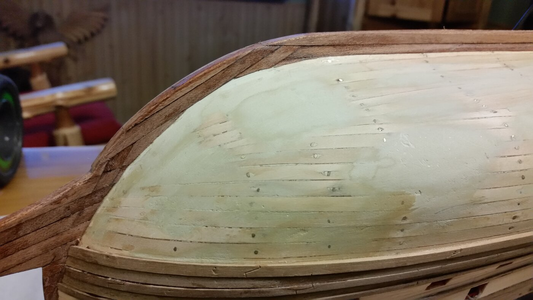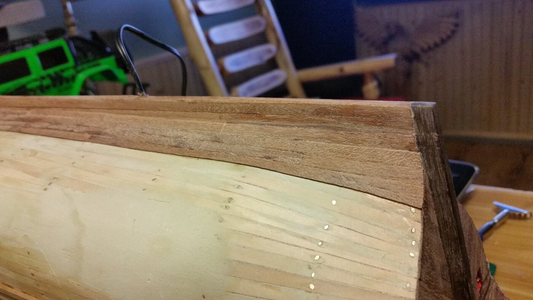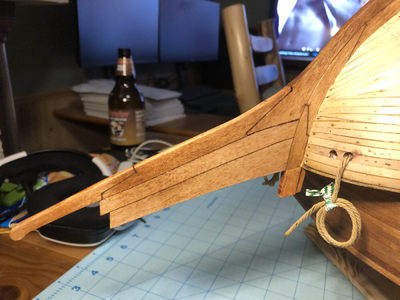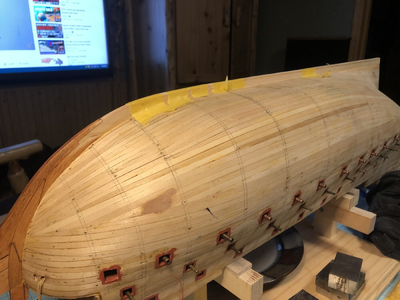Signet is right about how good layering hardwood over the plywood false keel can look. Here is what you can do without cutting off the false keel and replacing it with solid hardwood. The advantage in leaving the false keel in place is that the strength of the hull framework is maintained, such that you can mount the model in a keel vise to hold it while you work on upper parts of the ship such as the deck and do the rigging. Attaching a new keel is slightly weaker, and bumping the ship while in the keel vice in an accident could break off the keel.
You can simulate the individual sections of the keel using hardwood veneers applied to the false keel, and the effect is pretty good, and easier than jig-sawing and assembling a solid keel in pieces. An example of a veneered keel is shown below on the French man of war
La Couronne. Using a brown permanent marker on ONE side of each joint will darken the lined between the veneer strips, which are made from mahogany below. You can cut the plank ends with sharp scissors for quick fitting. A strip of 1mm hardwood along the bottom edge of the keel simulates the false keel (not to be confused with the plywood model keel piece). The false keel was a strip designed to take wear and damage from grounding, and could be easily replaced compared to repairing the keel if damaged. In the example below, the seam between the false keel and the side veneer strips is practically invisible, and veneer was used on this model because I was unaware of the false keel construction found on actual ships at the time. The pattern of even strips on the stem assembly is only partially accurate. (Keep reading).
View attachment 334060
Here you can see how the keel veneers blend into the hull planking near the stern, which will be installed later. Note how the surface of the planking is even with the sides of the sternpost, in this case made from solid walnut. Your wood choices will vary.
View attachment 334063
Unlike the first model, the stem assembly on this model below was not veneered with strips, but assembled from solid hardwood. Even strips of veneer on the previous ship's stem were not the proper joint arrangement. The seams are actual glued seams mixed with simulated seams made with cuts from a chisel shaped razor knife and stained. The shapes of the parts of the stem assembly could be simulated much more easily with sheets of veneer cut into puzzle piece shapes like this which properly simulate the timber piece shapes and glued to the plywood false stem, and the final effect would look very close. The hard part is locating a historic reference source that can show you what these shapes are for your type of vessel, and all ships varied greatly in this regard if you tell us which ship your are building. Other members can help you with this information. Also, when assembling solid pieces of hardwood and eliminating gaps in the joints is a real pain. Gaps have to be filled with a thick mixture of PVA glue and sawdust, and stained after sanding. The stem assembly below is made from solid maple, and needs to be stained a few shades darker.
View attachment 334065
Here you can see the 1.5mm thick false keel with masking tape holding it until the glue dries. It is a series of strip sections, about 4-5 of them starting from a point at the forward edge of the forward most piece of yellow tape, and extending aft until it touched the forward most edge of the sternpost.
View attachment 334066




